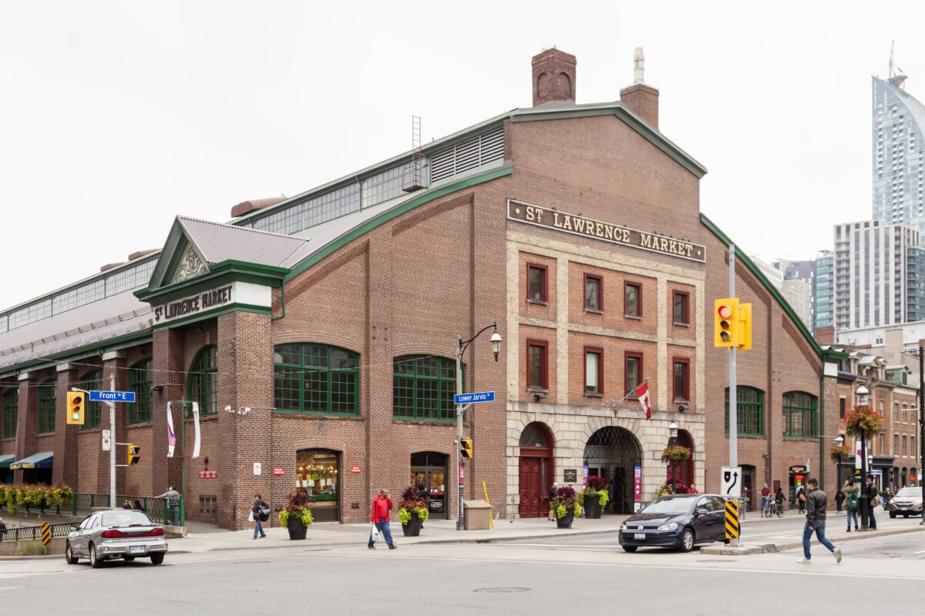
Imagine Toronto as a finely decorated table, with High Park acting as the flower arrangement to the left side, and The Danforth representing a chilled bottle of Ouzo plonked on the right end of the spread. Smack dab in the centre of the table, you’ll find the centrepiece – a luxuriant, inviting display of fine food, cased inside gorgeous antique dinnerware.
This centrepiece is the historic St. Lawrence Market.
The St. Lawrence Market is an enduring symbol of community, history, and good living in Toronto. In this article, your top Toronto real estate company is giving it the spotlight it deserves. Join Harvey Kalles Real Estate as we explore the history, transformations, people, and cultural significance of the great SLM.
St. Lawrence Market’s Early History
If you’re like most Torontonians, you’ve probably seen St. Lawrence Market a thousand times, whether walking to work or on a family summer adventure downtown. But how many can say they really know the market? Most of us take the building for granted as this sprawling, antiquated gem in the heart of the city – yet its history is pure Toronto.
First, it’s the city’s oldest market, dating back to 1803. Back then, it was a wood-structured building sitting at the corner of Front and Jarvis. Farmers, fishers and merchants would convene from across the modern GTA (then York) to hawk their provisions, and several more would make the long trek in to buy those goods. Before long, a kind of cottage industry popped up around the market, with taverns and pubs catering to regional shoppers who’d made the long journey into town.
As brick became Toronto’s material of choice, the market underwent its first of several changes – this time, swapping wood for brick. And that’s the building we see today, right?
Not quite yet.
Out of the Fire, Into the Frying Pan: The Market’s Long Evolution
That original brick structure would probably still be intact if not for the Great Fire of Toronto in 1849. Starting at a tavern near King and Nelson, the fire quickly expanded to engulf a considerable portion of the central business core, SLM included. Once again, the city needed to start from scratch.
In 1850, it built what’s now (basically) the South Market we see today. Yes, SLM underwent countless other revisions and renovations, but it’s more or less the same structure that followed the Great Fire.
With its newly pressed bricks and (for the time) modern architectural panache, St. Lawrence Market slowly evolved into the Toronto centrepiece we know today. Throughout its history, it has served several purposes, sharing space with city council chambers, jail cells, public punishment sites, the Mayor’s Office… all while playing double duty as a food market.
However, at a certain point, all of those public service workers felt too crowded in the market. And by the 20th Century, they’d left for new spots like (Old) City Hall and newly minted police buildings. What remained were the OG inhabitants of the central market – the hard-working vendors and food purveyors.
During this period, the market slowly but surely gained a reputation for being two things: an indelible cultural landmark in Toronto, and a hotspot for great groceries and delicious fare. In the 70s, the South Market found a partner in the newly constructed North Market, and the city designated the original structure one of the first heritage sites in Toronto, formally recognizing its cultural and architectural significance.
The Enduring Legacy of St. Lawrence Market
Since the 70s, St. Lawrence Market’s star has continued to rise. Following a tourist boom in the early 2000s, SLM cemented itself as a hub where travellers exploring the city could get quintessential Hogtown delicacies like peameal bacon and maple syrup. In 2011, National Geographic picked it as one of the 10 best markets in the world. And it became a natural mecca during the foodie movement of the last 20 years; its vendors supply several of Toronto’s top restaurants, and the market itself hosts executive chef cooking classes, food courses, and more.
What’s the enduring legacy of St. Lawrence Market? The market started as a meeting place to celebrate the Southern Ontario bounty. It transformed itself to respond to demographic changes and hardship. And it emerged in modern times as a welcoming space for tourists and locals alike to celebrate the unique local culture. In many ways, the story of St. Lawrence Market is the story of Toronto itself.
Vendors, Merchants and Famed Purveyors: The People Who Make SLM Special
The building is beautiful on its own. However, SLM owes its prestige to the people and businesses that populate it. Whether you’re looking for a peameal sandwich, fresh Ontario lake trout, local fiddleheads, or pastries and other desserts, the market’s got you covered. Here are a few of our favourite locally-owned independent businesses operating out of the historic St. Lawrence Market:
- Carousel Bakery: Maurice and Robert have been turning out top-notch peameal sandwiches in this spot for over 30 years, making it a contender for one of the city’s best brunch restaurants.
- Buster’s Sea Cove: Another 30-year-old institution, Tom Antonarakis’ ode to great seafood is another hit with the lunch crowd (the lobster roll is particularly great).
- Ponesse Foods: One of the original vendors, Ponesse opened shop in 1900 and continues to offer high-quality fruit and vegetables.
- Uno Mustachio: Celebrating 40 years of business this year, the Italian SLM staple pumps out Toronto’s favourite sandwiches from the old country – the veal and eggplant parmigianas, combined in one sandwich here as The Godfather.
- Scheffler’s Delicatessen & Cheese: Founded in 1955, Scheffler’s is still our go-to when putting together a celebratory charcuterie board; its wide array of cheeses, meats, olives, spreads and import items is unparalleled.
- Family Food Market: Owner Li Chunan Hsiung has run this fresh food and vegetable business for 25 years, gaining notoriety with local chefs and gourmands.
These are just a few of the businesses and people that help make St. Lawrence Market an unmissable Toronto gem. For the full experience, take your tote bags down to the market, arrive with an empty stomach, and bask in one of the city’s most culturally rich – and delicious – experiences.




